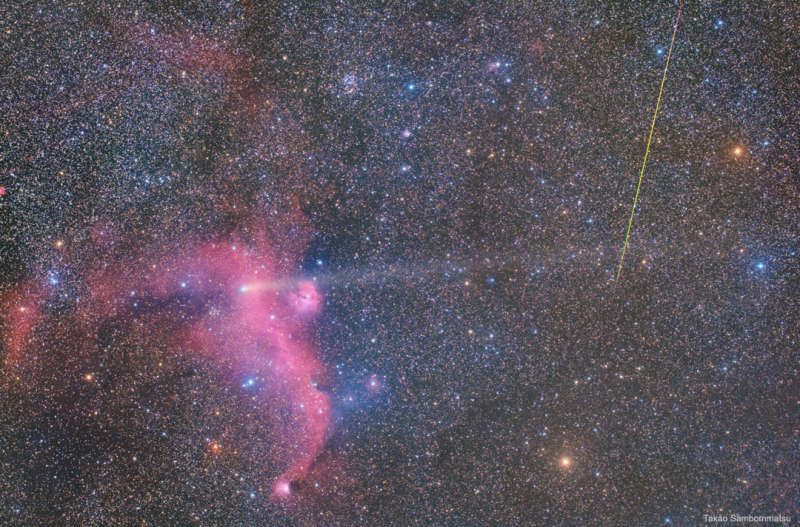Credit & Copyright: Takao Sambommatsu
Explanation:
A meteor, a comet, and a photogenic nebula have all been captured in this single
image.
The closest and most fleeting is the streaking meteor on the upper right -- it was
visible for less than a second.
The meteor, which disintegrated in Earth's atmosphere, was likely a small bit of
debris from the
nucleus of
Comet 21P/Giacobini-Zinner, coincidentally the comet captured in the same image.
Comet 21P, pictured across the inner
Solar System from Earth, is distinctive for its long dust tail spread horizontally
across the image center.
This comet has been visible with binoculars for the past
few months but is
now fading as it heads back out to the orbit of Jupiter.
Farthest out at 3,500 light years distant is the IC 2177, the
Seagull Nebula, visible on the left.
The comparatively vast
Seagull Nebula, with a wingspan on order 250
light-years, will likely remain visible for hundreds of thousands of years.
Long exposures, taken about two weeks ago from
Iwaki-City in
Japan,
were combined to capture the image's faintest elements.
You, too, could see a meteor like this -- and perhaps
sooner than you might think: tonight is the peak of the
Orionids
meteor shower.
1999 2000 2001 2002 2003 2004 2005 2006 2007 2008 2009 2010 2011 2012 2013 2014 2015 2016 2017 2018 2019 2020 2021 2022 2023 2024 2025 |
Yanvar' Fevral' Mart Aprel' Mai Iyun' Iyul' Avgust Sentyabr' Oktyabr' Noyabr' Dekabr' |
NASA Web Site Statements, Warnings, and Disclaimers
NASA Official: Jay Norris. Specific rights apply.
A service of: LHEA at NASA / GSFC
& Michigan Tech. U.
|
Publikacii s klyuchevymi slovami:
meteor - comet - Meteor - komety - tumannost'
Publikacii so slovami: meteor - comet - Meteor - komety - tumannost' | |
Sm. takzhe:
Vse publikacii na tu zhe temu >> | |
